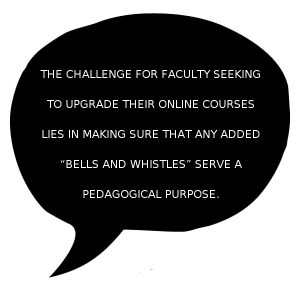Author and Editor: Dr. Shelly Wyatt
Dear ADDIE:
In many ways, I have a happy problem: the faculty at my institution have embraced online teaching and recognize its benefits to their students, the university, and themselves. As they gain experience in developing and delivering online course content, many faculty have expressed the desire to take their online courses beyond the basics and make them more engaging. Recently, I spoke with a faculty member (“Sally”) who shared her desire to take her online courses to the next level. Sally told me that, while she is happy with her online courses, she is concerned that her courses have grown stale. What is the shelf-life of online course content, she asked? At the same time, Sally expressed concern regarding throwing off her students by introducing technology that may be unfamiliar to them. Sally was clearly experiencing that tension between staying with the tried-and-true (voice-over presentations, online quizzes) and embracing new technologies and approaches that may inject new energy and interest in the course but have the potential to overwhelm or frustrate students. Put simply: Sally wants to jazz up her course but would like guidance on how to go about it.
Do you have any suggestions to help me guide this instructor as she works towards making her online courses more engaging?
Signed,
Revved Up about Supercharging Online Courses
Dear Revved Up:
You are so right—this is a happy problem! Now that the online modality has been firmly established at many colleges and universities, faculty who have been developing and teaching online courses for several years or more recognize that there may be a lot more that they can do to improve their courses. The challenge for faculty seeking to upgrade their online courses lies in making sure that any added “bells and whistles” serve a pedagogical purpose. For instructional designers and faculty developers, this means the support you provide may vary more according to the discipline. 
The first and most important step in working with a faculty member who wants to jazz up his or her course is to identify an area, assignment, assessment, or activity that could benefit from redesign. Criteria for selecting an area or activity could include how long ago the assignment or activity was created, level of engagement demonstrated by previous students, publication or availability of new materials, and excitement concerning a new tool or capability made available in the LMS. Conversely, a faculty member may want to explore areas in the course that could be improved by creating new content. Another area that may not be obvious but represents a rich opportunity to supercharge an online course and increase engagement involves creating an engaging online persona. Although it can be an amorphous concept that defies easy description, an instructor’s online persona is the degree to which the instructor develops his or her digital presence. Simply stated, a faculty member’s online persona is a function of the instructor’s accessibility, responsiveness, personality, humor, and care. Online tools that can help faculty convey their online teaching persona include: instructor introduction and photograph, discussion that includes biography and welcome message, office hours and discussions through online chat, introduction and content videos, video capture, and daily/weekly announcements (TOPkit “Sample Course,” Module 1).
For advanced online instructors, the support of an instructional designer is just as vital as it is for those instructors who are just beginning to develop and teach courses online. Indeed, the role of the instructional designer in supporting the development of more engaging courses is often key; opportunities to increase engagement may be found not in using a new tool or resource but in applying sound principles of instructional design. Often overlooked by even the most skilled and dedicated online instructor is the alignment of content, activities/assignments, and assessments; all the shiny bells and whistles in the world won’t compensate for a course that’s disjointed or poorly designed.
There are lots of great resources for faculty who want to improve engagement in their online courses. One powerful resource is the Teaching Online Pedagogical Repository (TOPR), a public resource for faculty and instructional designers interested in online and blended teaching strategies. TOPR offers examples of how to incorporate a wide range of tools using sound pedagogical principles, including how to create screencasts that can help students grasp hard-to-explain concepts and how to use social networking tools to share real-time information related to the course content. Student collaboration represents another opportunity to increase engagement in online courses. Examples of online collaboration in TOPR includes peer review activities and using wikis to facilitate group projects.
Another excellent resource is the “Sample Courses” section of the TOPkit website. There are two versions of the sample development course (10 week version & 5 week light version) that is based on UCF’s IDL6543 professional development course that is used to credential faculty to create and teach blended or completely online courses. Both versions of the sample course contain a module titled “Enhancing Your Course with Emerging Technology” that provides an overview of popular online tools (e.g., video conferencing, social networking, social bookmarking, blogs, adaptive learning) along with instructional strategies and best practices.
Looking forward, digital textbooks are another technology that can make a difference for students in online courses. According to TOPkit’s Sample Course, “Some are exact replicas of the print textbook, while other offer basic features like highlighting and annotating. Some cutting-edge digital textbooks exhibit interactive features such as quizzes, simulations, and embedded multimedia. Searching for keywords helps students quickly locate a relevant part of the book, while interactive quizzes guide students to check for understanding as they read.” As the use of mobile devices to access course content increases, students’ devices serve as their textbook that, for them, can and should be a dynamic experience that offers more than just static text.
In addition to the examples of I have included here, what are some other ways instructional designers can support faculty who want to take their online courses to the next level? And how can we, as instructional designers, encourage more faculty to take on this challenge? Please share your thoughts with our TOPkit community on LinkedIn!
